Coming right off the Beasts of the land and sky, we continue with the … stuff that dwells under the sea. Quite a few Fish and Aqua Rahi made their debut from BCOR / BBTS / BPEV, and in contrast to the Beast-Warrior snub, Sea Serpents are technically included in the range of support because they will be joining the archetype at some point in the future. All that planning in advance is paying off!
So what is it that sets this trio of Types apart from previously considered Rahi to justify being treated as their own deck? Probably the biggest point is that they do not really aim to combo into Synchro boss monsters, but rather directly use their small pieces as recurring disruption in more of a low-investment control style of gameplay. Perhaps the best point to start from is therefore the specimen that mainly achieves this function in an offensive capacity: The Ruki.
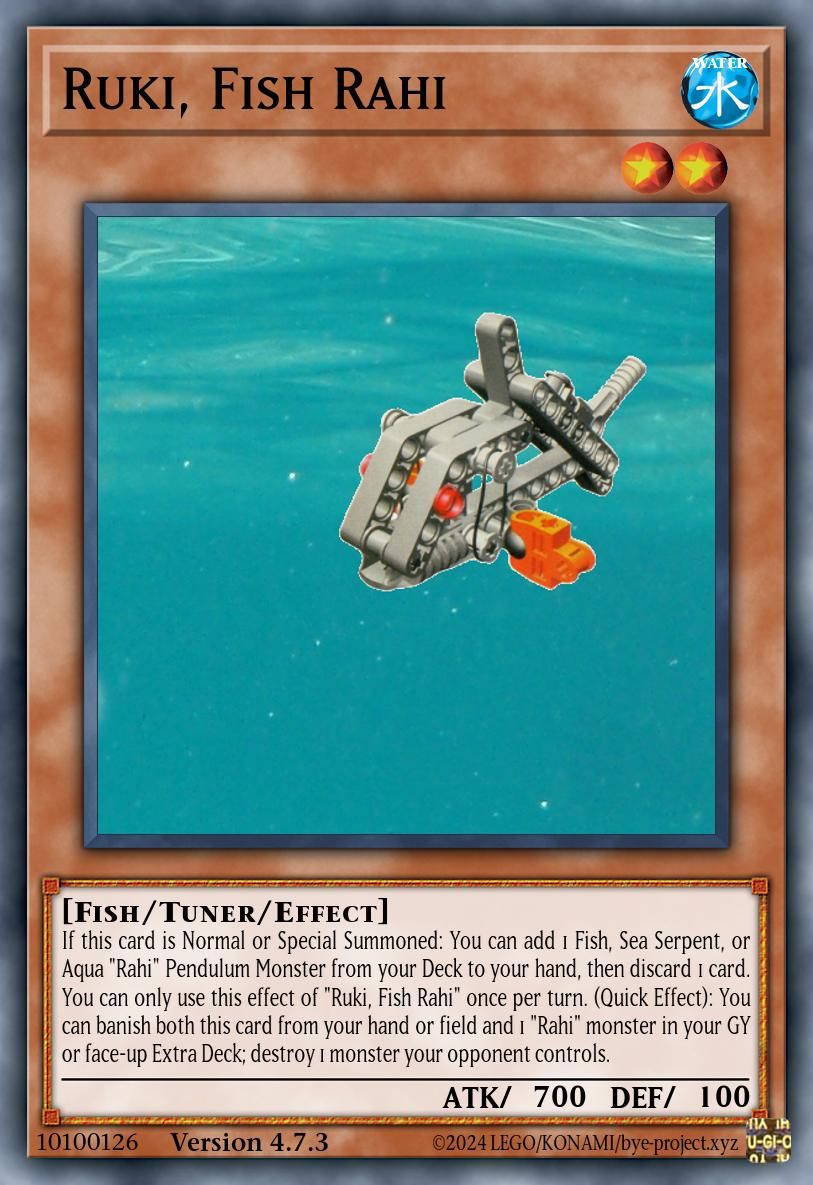
Ruki, Fish Rahi
Tuner Effect MonsterLevel 2 | WATER Fish | ATK 700 / DEF 100If this card is Normal or Special Summoned: You can add 1 Fish, Sea Serpent, or Aqua “Rahi” Pendulum Monster from your Deck to your hand, then discard 1 card. You can only use this effect of “Ruki, Fish Rahi” once per turn. (Quick Effect): You can banish both this card from your hand or field and 1 “Rahi” monster in your GY or face-up Extra Deck; destroy 1 monster your opponent controls.
The magic here is in the last line – “destroy 1 monster your opponent controls”, throwing this fish and its chompy biters as a potentially devastating wedge into their plans. Before that, of course, is a cost that loses you not only the Ruki from hand or field but also requires some banishing fodder in GY and Extra Deck … but then before even that, we have a convenient effect that provides just that setup if you manage to Summon first. So ideally you want to put this on the field to take advantage of that ability, but once things are rolling it’s also capable of lurking in your hand as a nasty surprise.
Of course, if nasty surprises from the hand are what you want, you can’t discount the Ruki’s partner in crime for the very early game. Meet the Shore Turtle.
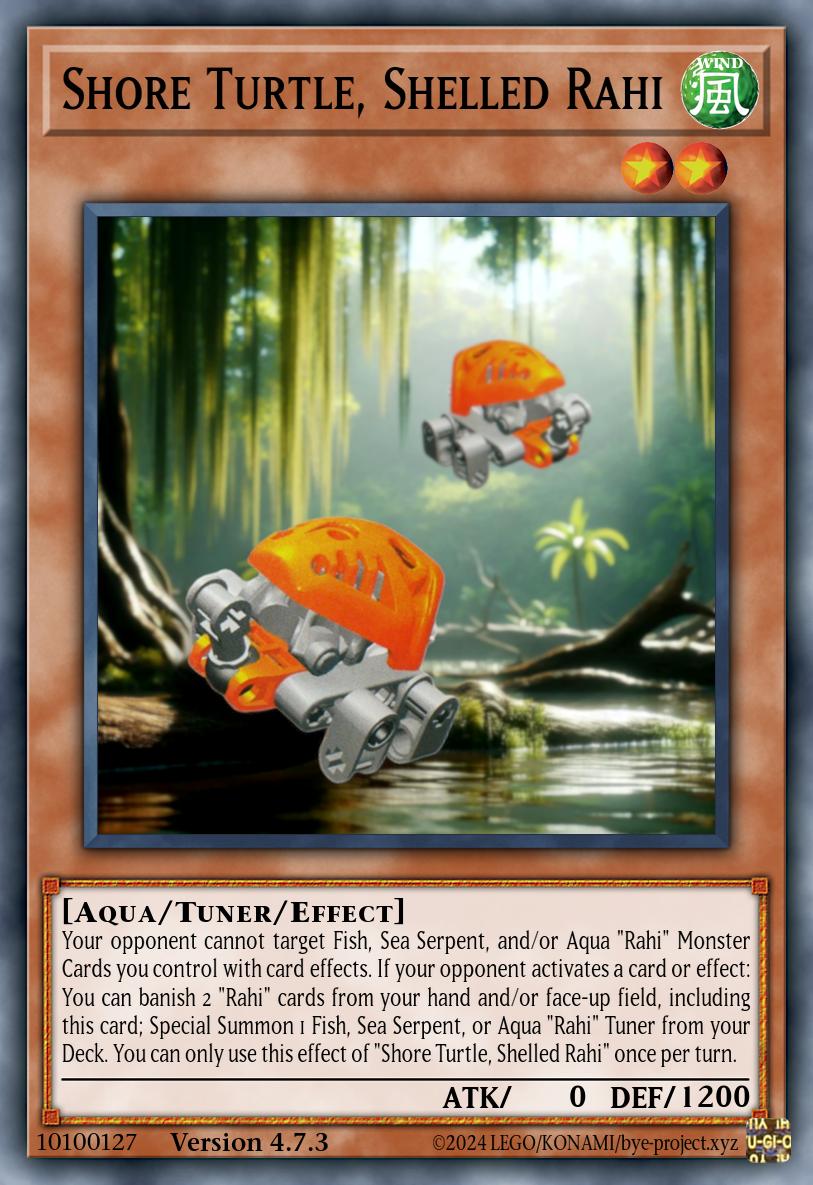
Shore Turtle, Shelled Rahi
Tuner Effect MonsterLevel 2 | WIND Aqua | ATK 0 / DEF 1200Your opponent cannot target Fish, Sea Serpent, and/or Aqua “Rahi” Monster Cards you control with card effects. If your opponent activates a card or effect: You can banish 2 “Rahi” cards from your hand and/or face-up field, including this card; Special Summon 1 Fish, Sea Serpent, or Aqua “Rahi” Tuner from your Deck. You can only use this effect of “Shore Turtle, Shelled Rahi” once per turn.
This flying amphibian (who even came up with that?) is the key that unlocks this deck’s potential for playing on turn 0 – the part of the game that’s often most vulnerable to disruption. Being a slow and harmless creature itself, it won’t react with a Quick Effect immediately when your opponent does something … but once it eventually notices, it does trigger on a new chain to bring out something like a Ruki, which will then also trigger on summon, and suddenly those monsters on the opponent’s field meant to go into a setup combo are looking awfully chompable. Alternatively, you could also go into another Shore Turtle for passive targeting protection if you’re already happy with your destructive capabilities. However, all this only works if you have another Rahi card to banish along with the turtle, so you’ll need to draw the right hand and having it stopped will hurt quite a bit.
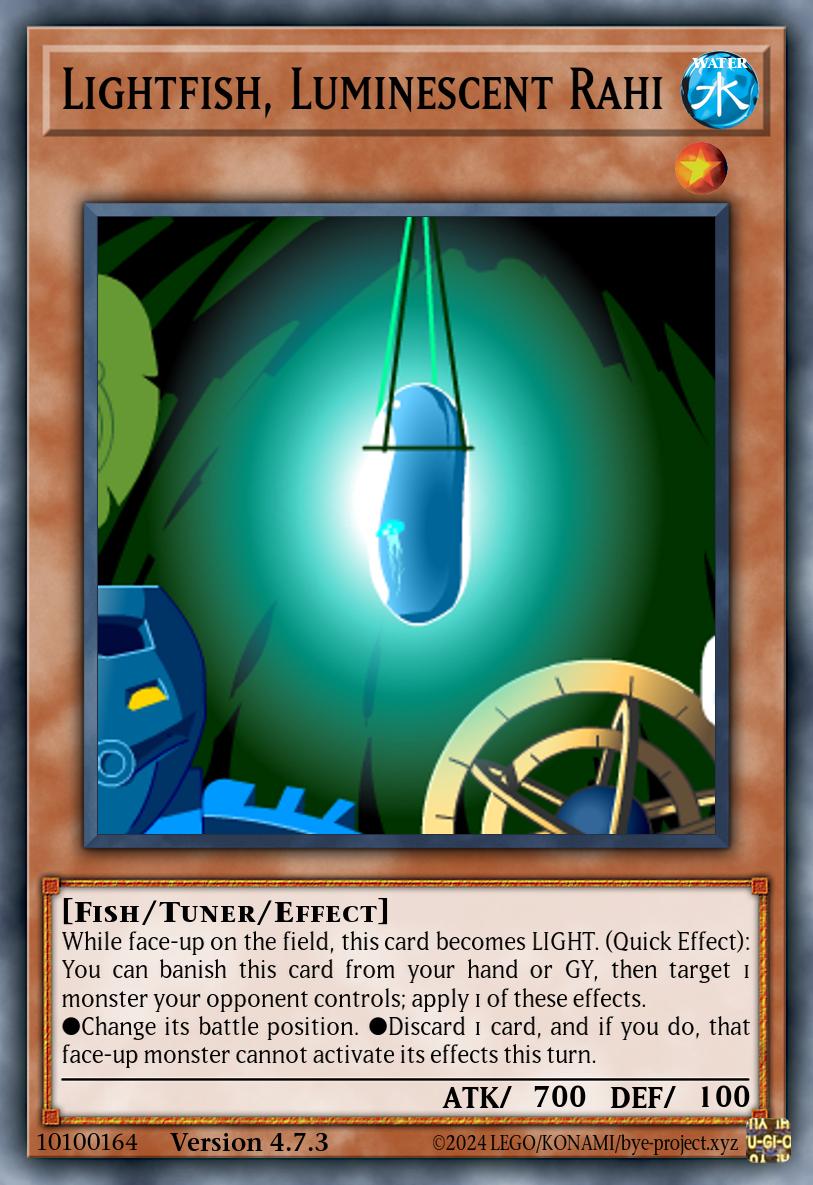
Lightfish, Luminescent Rahi
Tuner Effect MonsterLevel 1 | WATER Fish | ATK 700 / DEF 100While face-up on the field, this card becomes LIGHT. (Quick Effect): You can banish this card from your hand or GY, then target 1 monster your opponent controls; apply 1 of these effects.
●Change its battle position. ●Discard 1 card, and if you do, that face-up monster cannot activate its effects this turn.
Third in the lineup of small Quick Effect stuff is a Level 1 Tuner original to the recent BCOR overhaul, representing the Lightfish that illuminate the huts of Ga-Koro . This one is more focused on the gimmick of also being useful in that village’s strategy as a very easily accessible, low-cost effect you can use to increase chain link numbers on the opponent’s turn, but it also isn’t totally out of place in the Rahi deck. Here, it acts as a very soft disruption, and possibly another way to enable a Ruki in the hand by discarding with the more powerful of its two effects.
So I think the idea is clear at this point – banish a lot of things, fuck with the opponent’s field, and hope they get annoyed and leave before they notice you’re pretty much out of resources. Right? Not quite, we haven’t yet seen the Pendulum Monsters that bring the essential recursive aspect into this whole loop.
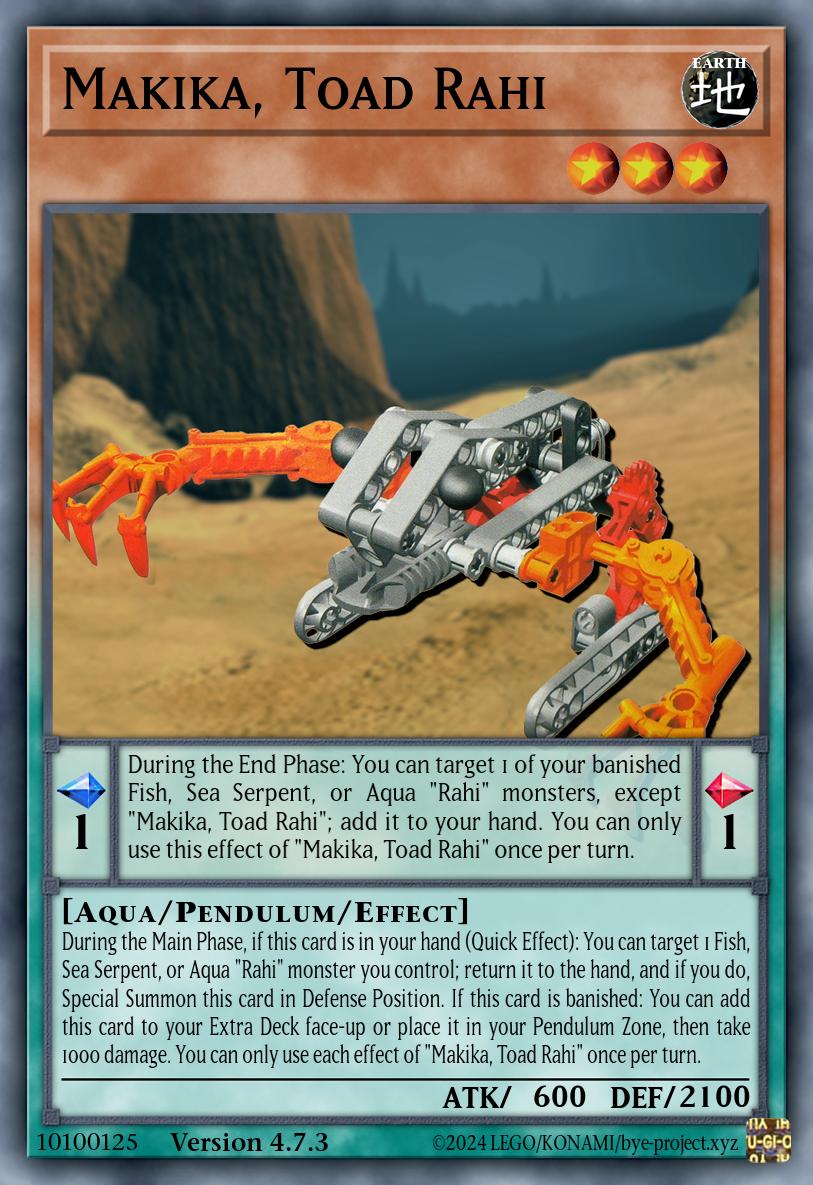
Makika, Toad Rahi
Pendulum Effect MonsterLevel 3 | Scale 1/1 | EARTH Aqua | ATK 600 / DEF 2100[ Pendulum Effect ]
During the End Phase: You can target 1 of your banished Fish, Sea Serpent, or Aqua “Rahi” monsters, except “Makika, Toad Rahi”; add it to your hand. You can only use this effect of “Makika, Toad Rahi” once per turn.
—————————————-
[ Monster Effect ]
During the Main Phase, if this card is in your hand (Quick Effect): You can target 1 Fish, Sea Serpent, or Aqua “Rahi” monster you control; return it to the hand, and if you do, Special Summon this card in Defense Position. If this card is banished: You can add this card to your Extra Deck face-up or place it in your Pendulum Zone, then take 1000 damage. You can only use each effect of “Makika, Toad Rahi” once per turn.
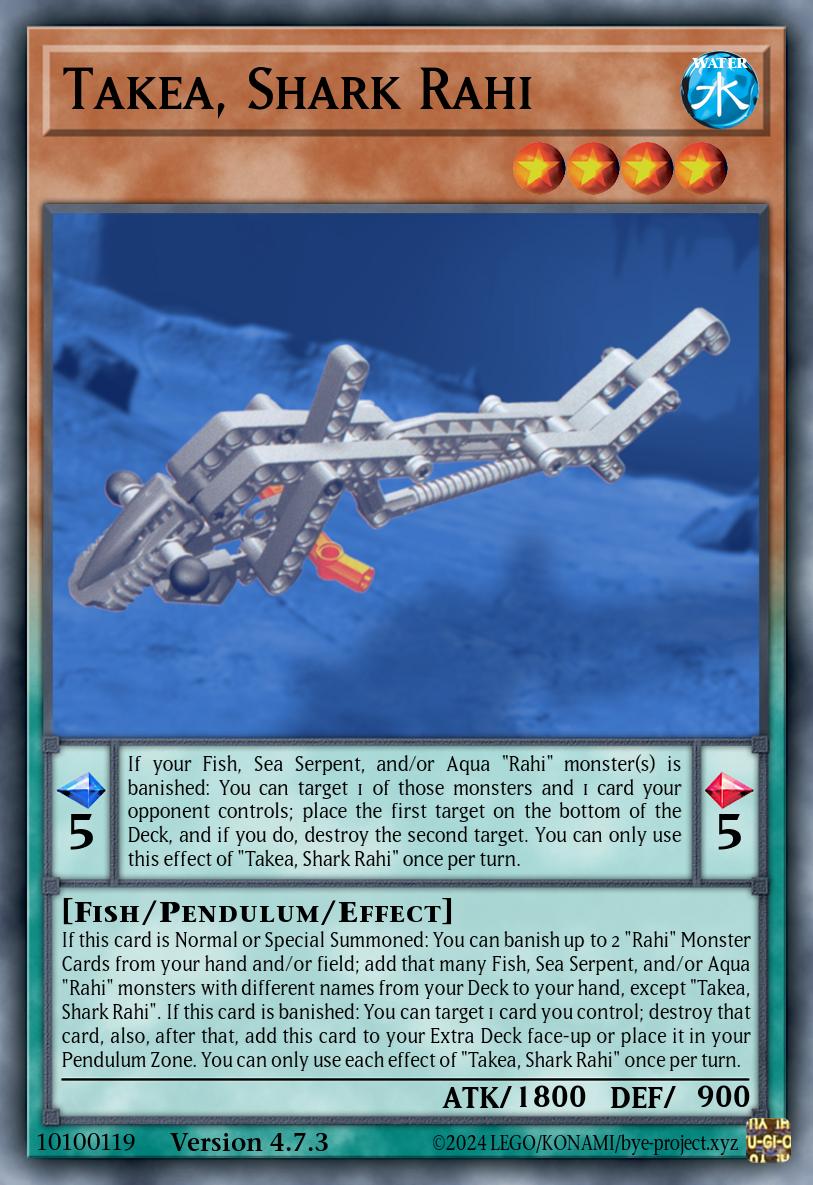
Takea, Shark Rahi
Pendulum Effect MonsterLevel 4 | Scale 5/5 | WATER Fish | ATK 1800 / DEF 900[ Pendulum Effect ]
If your Fish, Sea Serpent, and/or Aqua “Rahi” monster(s) is banished: You can target 1 of those monsters and 1 card your opponent controls; place the first target on the bottom of the Deck, and if you do, destroy the second target. You can only use this effect of “Takea, Shark Rahi” once per turn.
—————————————-
[ Monster Effect ]
If this card is Normal or Special Summoned: You can banish up to 2 “Rahi” Monster Cards from your hand and/or field; add that many Fish, Sea Serpent, and/or Aqua “Rahi” monsters with different names from your Deck to your hand, except “Takea, Shark Rahi”. If this card is banished: You can target 1 card you control; destroy that card, also, after that, add this card to your Extra Deck face-up or place it in your Pendulum Zone. You can only use each effect of “Takea, Shark Rahi” once per turn.
The Makika and Takea form a pair, with the former having a defensive and the latter an offensive focus. This is most apparent in the Pendulum Zones, where the shark sends the things you keep banishing for cost back into the Deck to cause even more destruction, while the toad hands them back to you in the End Phase to enable plays for the next turn. On the field, the main one to watch out for is the Takea, as it pays its own banishing cost to search out just the tools you need, but the Makika’s Quick Effect to Special Summon itself can also put in some serious work such as letting a Ruki safely dodge a boardwipe.
Finally, both of them share an ability that vastly improves the math on the supposed massive loss of cards incurred by all the banishing: If they themselves are used this way, they will, in exchange for some sort of drawback, swim right back to either the Extra Deck or the Pendulum Zone and continue to act as valuable resources. In the voracious Takea’s case, the drawback is that you must offer it another of your cards as food, while the Makika causes you damage with its poisonous skin.
And that was, as far as the initial BCOR wave is concerned, all the pieces involved in the Fish/Sea Serpent/Aqua strategy! Well, except for one that didn’t really ever come up. You see, since the small monsters are, technically, Tuners, we do have the ability to go into Synchros. And there is one really big one that does align with these Types: The Mana Ko, secret guardian of Makuta’s lair.
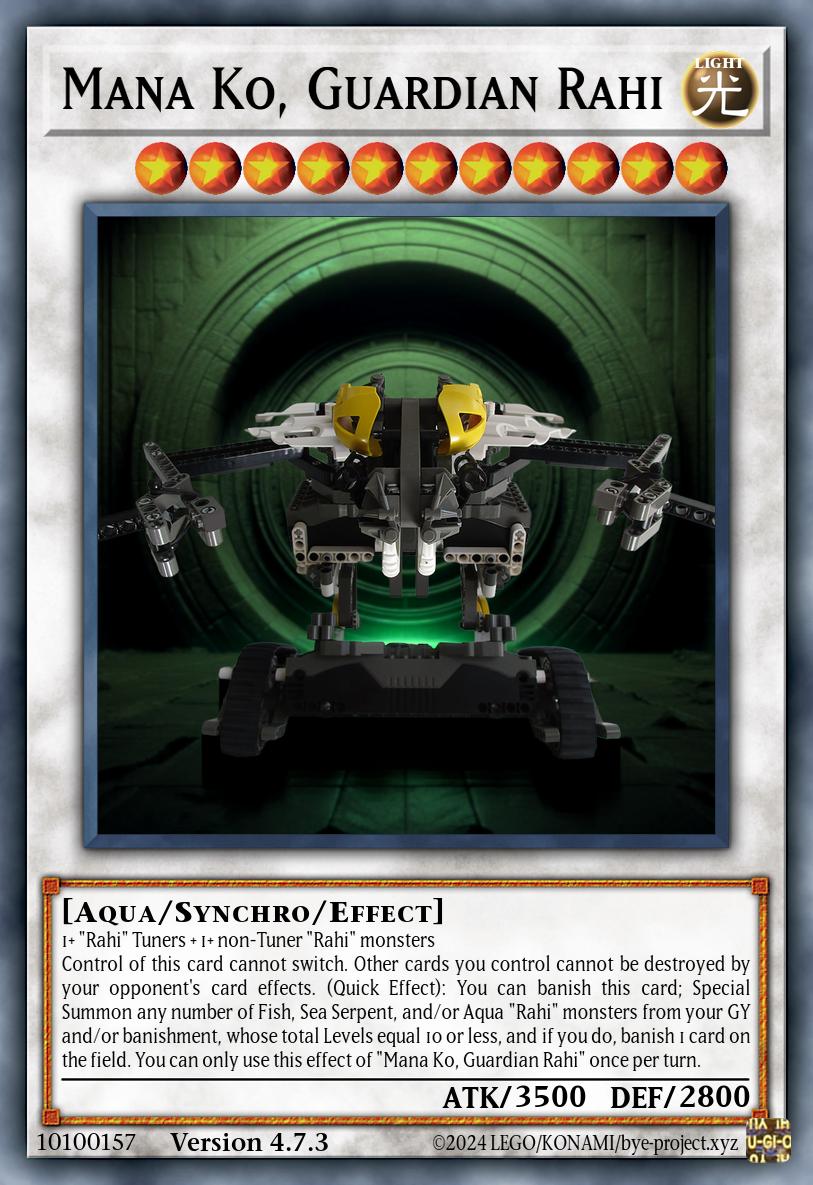
Mana Ko, Guardian Rahi
Synchro Effect MonsterLevel 11 | LIGHT Aqua | ATK 3500 / DEF 28001+ “Rahi” Tuners + 1+ non-Tuner “Rahi” monsters
Control of this card cannot switch. Other cards you control cannot be destroyed by your opponent’s card effects. (Quick Effect): You can banish this card; Special Summon any number of Fish, Sea Serpent, and/or Aqua “Rahi” monsters from your GY and/or banishment, whose total Levels equal 10 or less, and if you do, banish 1 card on the field. You can only use this effect of “Mana Ko, Guardian Rahi” once per turn.
This Level 11 bungus can, for example, be made by tuning a Ruki, a Shore Turtle, a Takea, and a Makika (2+2+4+3) … and I think you can see just why it never came up. If you were ever to find yourself in that situation, it could kind of be worth it for the big body, blanket protection, and ability to tag out into almost all of its materials with bonus removal (warning: may hit your own cards). But you probably don’t really need it to win the game at that point.
However, the tag-out concept seemed so good that it ended up inspiring the other, much more reasonably positioned Synchro Monster introduced with the BBTS support.
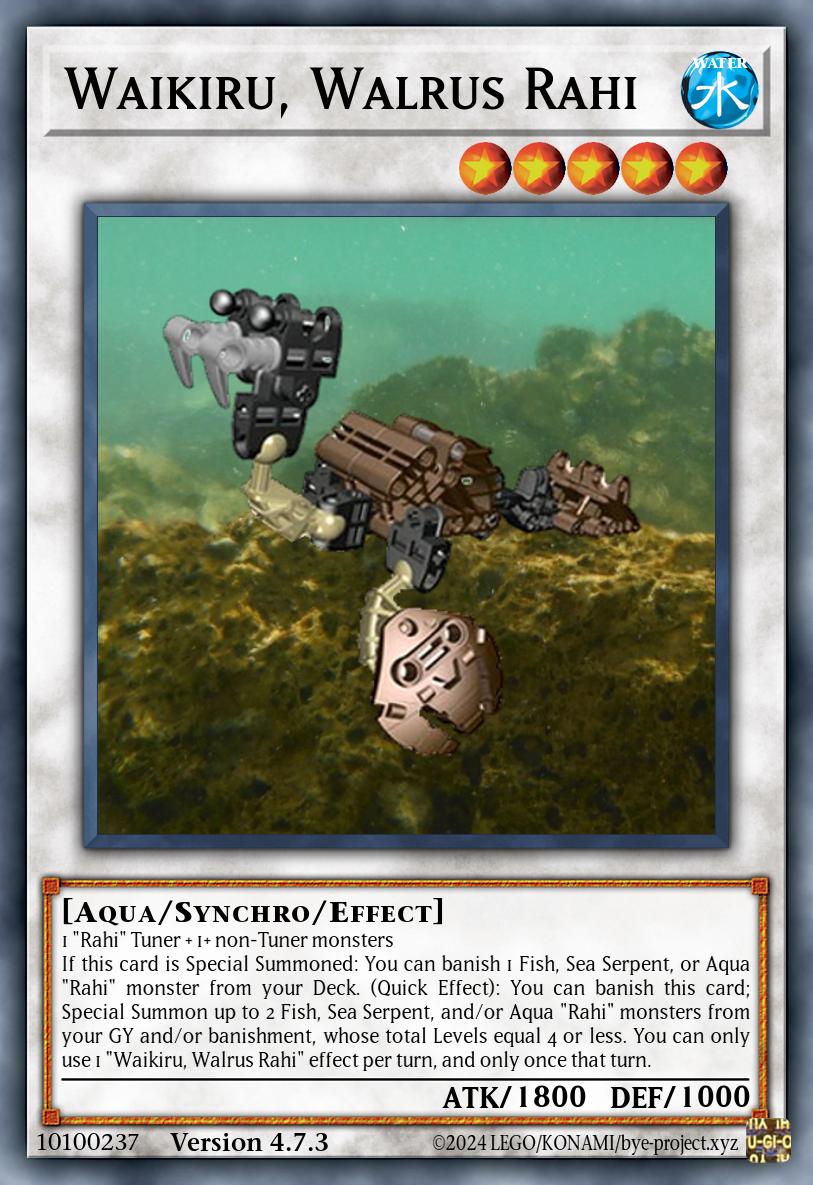
Waikiru, Walrus Rahi
Synchro Effect MonsterLevel 5 | WATER Aqua | ATK 1800 / DEF 10001 “Rahi” Tuner + 1+ non-Tuner monsters
If this card is Special Summoned: You can banish 1 Fish, Sea Serpent, or Aqua “Rahi” monster from your Deck. (Quick Effect): You can banish this card; Special Summon up to 2 Fish, Sea Serpent, and/or Aqua “Rahi” monsters from your GY and/or banishment, whose total Levels equal 4 or less. You can only use 1 “Waikiru, Walrus Rahi” effect per turn, and only once that turn.
For the much more pragmatic cost of a Ruki/Turtle and a Makika (or a Lightfish and a Takea), you get a topical way to get another monster from your Deck into rotation, and on the next turn you can make a swap into a pair of Tuners, or a single Pendulum, or whatever else you can fit in 4 Levels. Also important to keep in mind that your Pendulum Scales can recycle this after it banishes itself for cost, so you get to do that move repeatedly if everything goes smoothly. And I guess I should note that targeting this with a banished Takea and then chaining it will still let the Takea fully resolve, that’s specifically why that effect is worded the way it is.
Speaking of Pendulum Scales, the second wave also introduced an additional pair of those, though rather than a proper pair like the first two, they act as more disconnected, situational options.
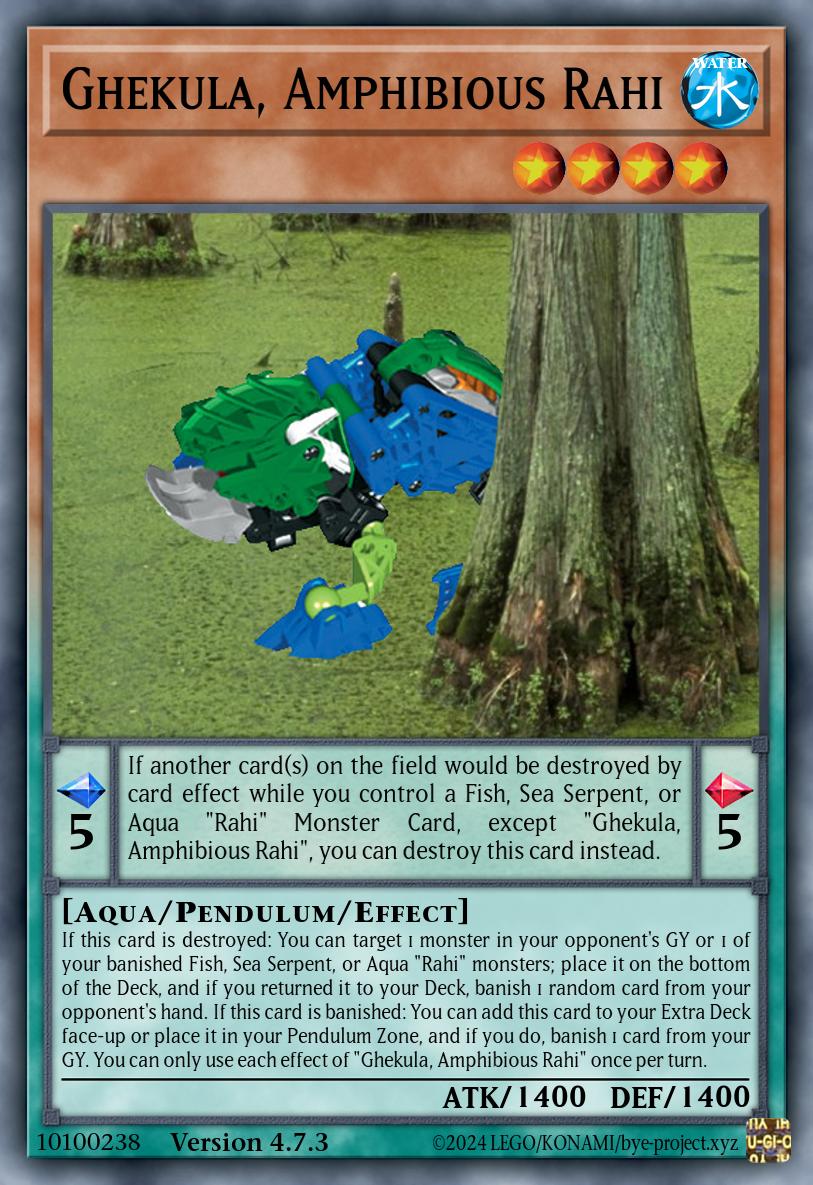
Ghekula, Amphibious Rahi
Pendulum Effect MonsterLevel 4 | Scale 5/5 | WATER Aqua | ATK 1400 / DEF 1400[ Pendulum Effect ]
If another card(s) on the field would be destroyed by card effect while you control a Fish, Sea Serpent, or Aqua “Rahi” Monster Card, except “Ghekula, Amphibious Rahi”, you can destroy this card instead.
—————————————-
[ Monster Effect ]
If this card is destroyed: You can target 1 monster in your opponent’s GY or 1 of your banished Fish, Sea Serpent, or Aqua “Rahi” monsters; place it on the bottom of the Deck, and if you returned it to your Deck, banish 1 random card from your opponent’s hand. If this card is banished: You can add this card to your Extra Deck face-up or place it in your Pendulum Zone, and if you do, banish 1 card from your GY. You can only use each effect of “Ghekula, Amphibious Rahi” once per turn.
The more traditional Ghekula is already somewhat weird in that its Pendulum Effect is destruction replacement to supplement the Shore Turtle’s protection, and only the monster effect that is then triggered by that has the usual capability to recycle your own banished monsters. This is based on the Matoran superstition that harming a Ghekula, even by accident, invites misfortune – so if it “accidentally” blows up while they try to destroy something else, it’s going to take something either out of their GY, or straight out of their hand if you have banishment setup. It also does the usual self-recycle if banished itself, this time demanding payment via the GY (the more thematic option would have been discarding from your hand, but it just isn’t worth it).
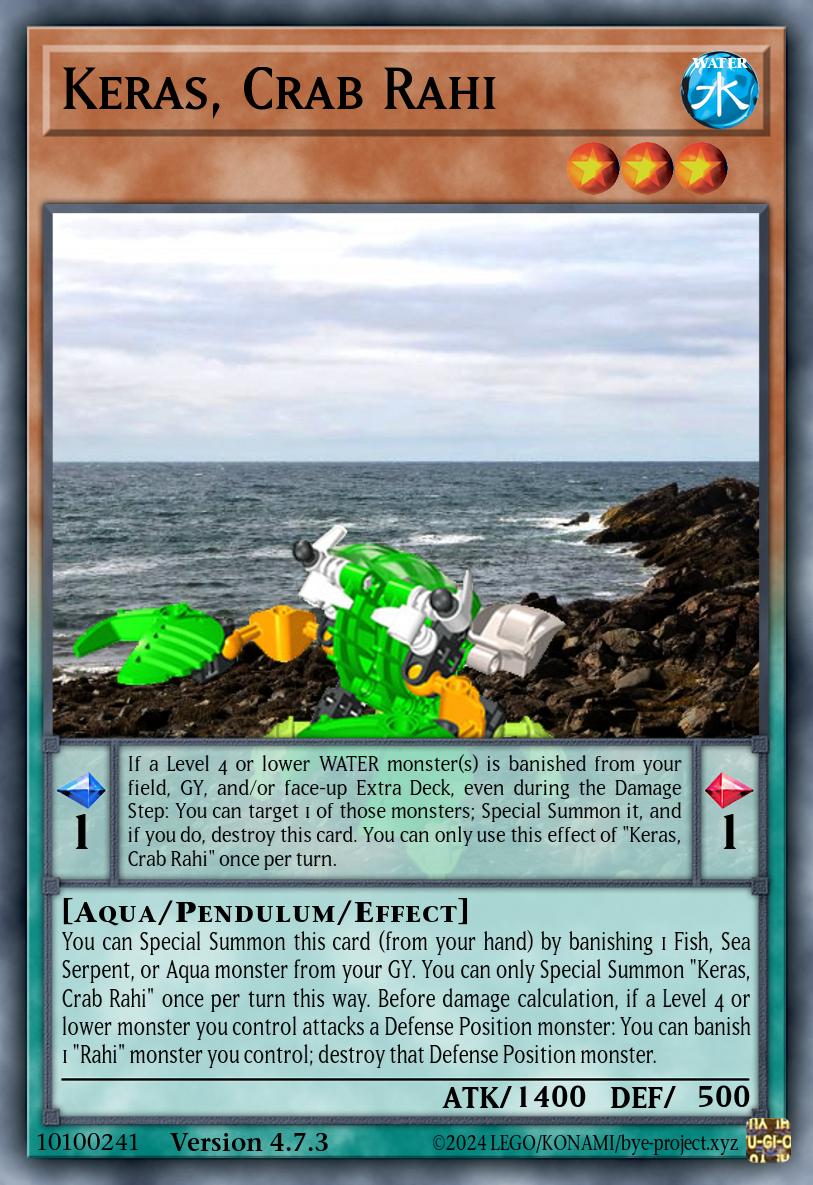
Keras, Crab Rahi
Pendulum Effect MonsterLevel 3 | Scale 1/1 | WATER Aqua | ATK 1400 / DEF 500[ Pendulum Effect ]
If a Level 4 or lower WATER monster(s) is banished from your field, GY, and/or face-up Extra Deck, even during the Damage Step: You can target 1 of those monsters; Special Summon it, and if you do, destroy this card. You can only use this effect of “Keras, Crab Rahi” once per turn.
—————————————-
[ Monster Effect ]
You can Special Summon this card (from your hand) by banishing 1 Fish, Sea Serpent, or Aqua monster from your GY. You can only Special Summon “Keras, Crab Rahi” once per turn this way. Before damage calculation, if a Level 4 or lower monster you control attacks a Defense Position monster: You can banish 1 “Rahi” monster you control; destroy that Defense Position monster.
The Keras, on the other hand, entirely abandons the premise of being recurring banish fodder, instead adopting a role of somewhat more generic support that could also go along with Ga-Matoran (who once rode them into battle against the Bohrok). In the Pendulum Zone, it has the most powerful recycling effect out of all of these and Special Summons the banished monster right back to the field, with the two drawbacks that it only works with WATER monsters (so no Shore Turtle or Makika) and destroys itself after doing this once. Being able to Special Summon itself while generating banishment setup (in reference to how they were tamed by feeding them fish) is a good way to get an additional body for a Synchro play, and if you’re up against defensive walls such as Bohrok, this card also acts as a handy way for your low-Level monsters to overcome them. Its regular use in the Rahi deck doesn’t really involve this part all that much, but when it comes up, having a second copy in the Pendulum Zone is funny, as “even during the Damage Step” makes it so your Rahi banished for cost comes right back to get another attack in.

MKT Fish, Biting Rahi
Tuner Effect MonsterLevel 3 | DARK Fish | ATK 900 / DEF 300If this card you control would be used as Synchro Material, you can treat it as a non-Tuner. During your opponent’s Main Phase, you can (Quick Effect): Immediately after this effect resolves, Synchro Summon 1 Synchro Monster, using only Fish, Sea Serpent, and/or Aqua monsters you control, including this card. You can only use this effect of “MKT Fish, Biting Rahi” once per turn.
Moving on to the next expansion, BPEV gives us just one new monster with the Makuta Fish (abbreviated to MKT to avoid unwanted archetype associations) – basically the Ruki’s larger cousin that only ever appeared in written form. If that sounds like it wouldn’t bring anything new to the table, you’re mistaken, because this Tuner is Level 3, and sometimes not a Tuner, and its disruption consists of a Quick-Synchro that unlocks a whole bunch of Extra Deck options (as we’ll see in the sample deck). It also happens to be one of the few DARK Rahi, but turns out that doesn’t matter much in this particular strategy. Perhaps one last thing for the list of weird traits would be that it’s a Rahi whose effect makes no reference to the Rahi archetype, so really it’s just here to be searchable by e.g. a Shore Turtle.
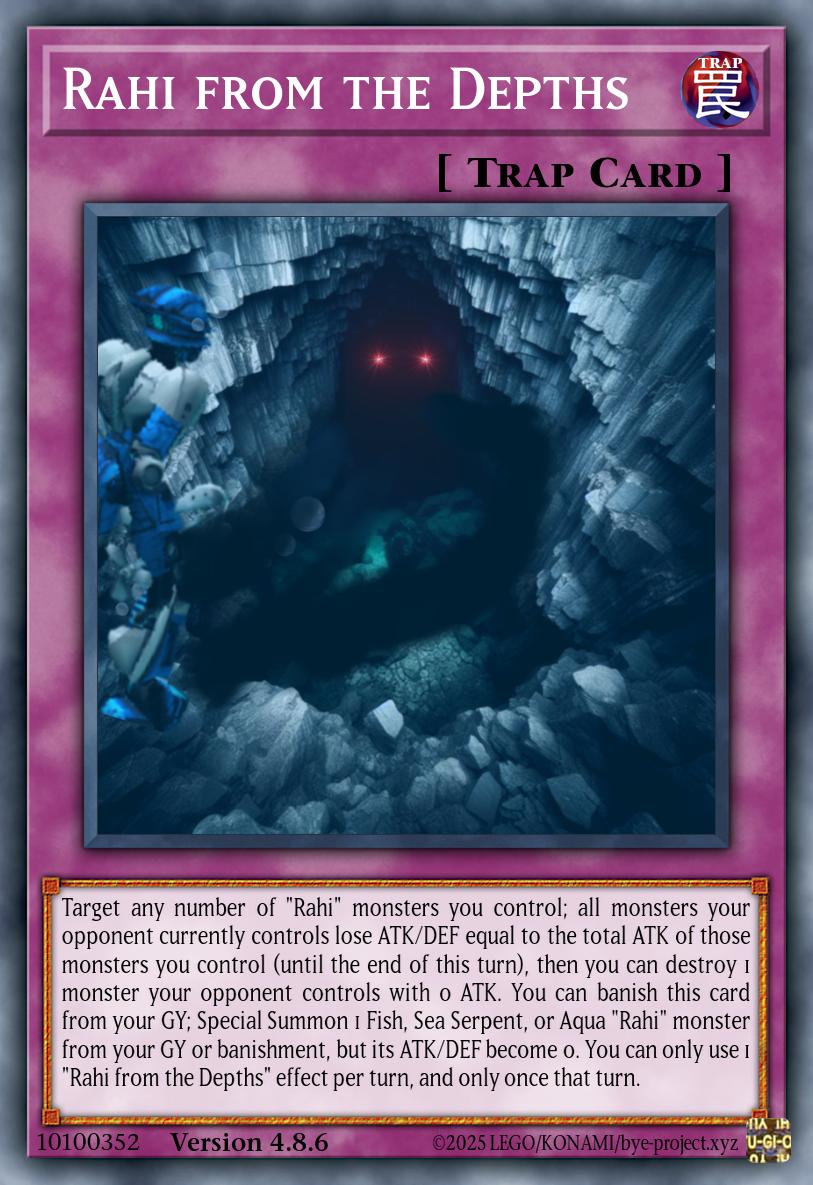
Rahi from the Depths
TrapTarget any number of “Rahi” monsters you control; all monsters your opponent currently controls lose ATK/DEF equal to the total ATK of those monsters you control (until the end of this turn), then you can destroy 1 monster your opponent controls with 0 ATK. You can banish this card from your GY; Special Summon 1 Fish, Sea Serpent, or Aqua “Rahi” monster from your GY or banishment, but its ATK/DEF become 0. You can only use 1 “Rahi from the Depths” effect per turn, and only once that turn.
The other piece of BPEV support is the archetype’s first Type-specific Trap Card, though its activation effect actually still works with all Rahi. Based on Gali’s encounter with the Great Temple Squid during the search for the Kanohi Nuva, the conceit of this card is that tentacles spring forth to restrain your opponent’s monsters, perhaps outright crushing weaker ones. That means it’s a non-targeting debuff with maybe destruction if the numbers line up right, which for most Rahi decks isn’t all that appealing in Trap form. But those Rahi that truly do hail from the Depths have the additional benefit of being able to use it for revival while it’s in the GY too, so it’s well worth playing with them at least.
Sample Deck
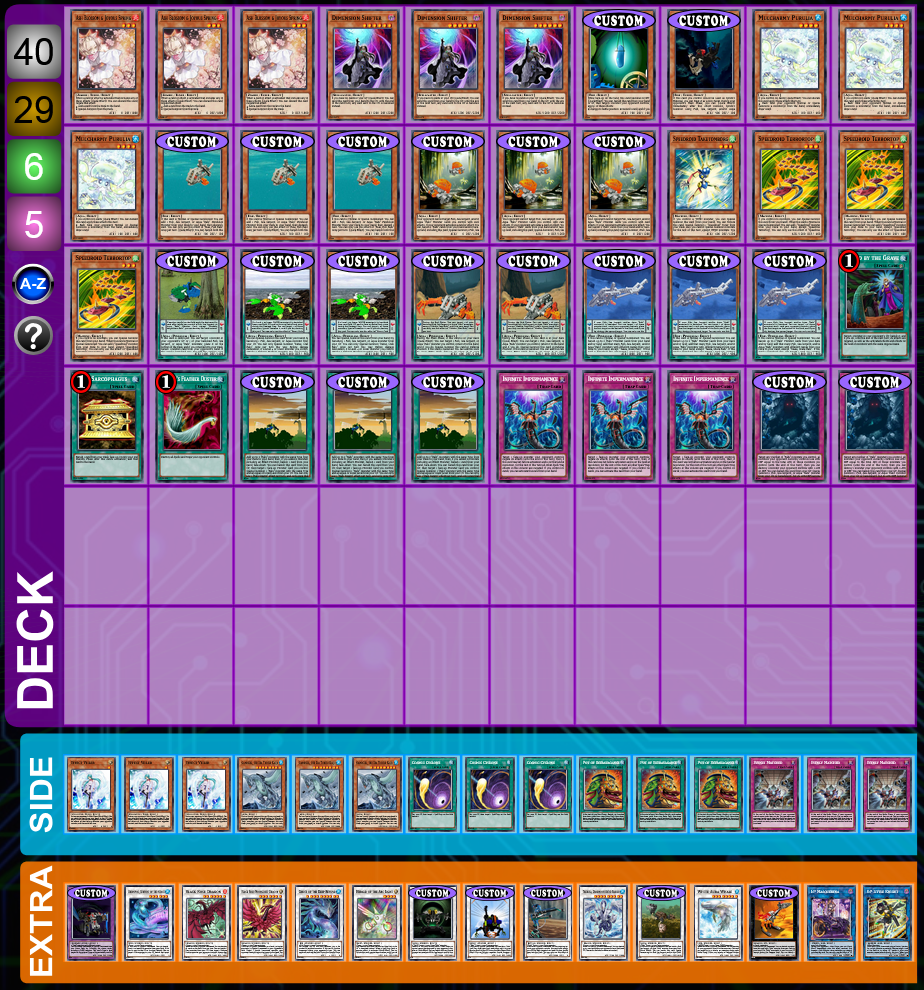
The main focus in-engine are the Ruki as our main frontline disruption, as well as the Shore Turtle and Takea that get us access to it. Makika and Keras get two slots each – while we’re generally okay with searching them, the fact that they can be Special Summoned from the hand makes them potentially useful in the opening hand as well. The Ghekula has no such advantage and is thus at a single copy, which also makes the ratios line up nicely at 4 low-scale and 4 high-scale Pendulum Monsters. We also run only 1 each of Light- and Makuta Fish , relying on Shore Turtle and Takea to get them as needed.
That leaves room in the Main Deck for “fun” cards such as the semi-recent roach reincarnation Mulcharmy Purulia (it’s Aqua!) and everyone’s favourite Dimension Shifter. While it wasn’t really my intent, this ended up being perhaps the world’s first Pendulum deck that thrives under Shifter due to the fact that all the Pendulums put themselves back into rotation even if they get banished. Even funnier: You can also play fairly well under Anti-Spell Fragrance (as I noticed in one game against the stun AI), because the scales don’t care about that restriction when they place themselves via their own effects!
The Terrortop package is in here as well, on the one hand for Hikaki access, and on the other because a hard-drawn Taketomborg can Special Summon itself if you have the WIND Shore Turtle on the field. That’s a Level 2 Rahi Tuner and a Level 3 non-Tuner, which adds up to a Waikiru and therefore a straight line into the rest of your Deck.
Otherwise, the Extra Deck space is mostly spent on Synchros that can be made from our various combinations of Levels 1 through 4. Herald of the Arc Light for convenient negation and banishing, Arionpos to get a scale from certain awkward positions, Black Rose (Moonlight) and Tarakava-Nui for removal and disruption (via Makuta Fish), White Aura Whale and Trishula for the same but with more stars, and our rarely seen big boss Mana Ko . There’s also a Rahi Nui in here (because Makuta Fish is DARK), but it doesn’t serve much of a purpose.
In general, a lot of the Extra Deck options here were just experimental and didn’t end up seeing use, so you could definitely cut some names and double or triple up on others – which is why Pot of Extravagance has a comfortable spot in the side deck. Along with some other generic good cards that may come in handy.
A sample video can be found below; the way it ends may surprise you …
Conclusion
The three Types Fish, Sea Serpent (eventually), and Aqua together form a Rahi deck that mostly forgoes combos and big boss monsters, instead trying to outgrind the opponent with a banishing resource loop that keeps disrupting them while keeping your own cards in play and moving. The general setup you aim for is to put your disruptive Tuners like Ruki and Makuta Fish on the field while backing them up with a pair of Pendulums that trigger various offensive or defensive bonus effects as you play. And whenever you do find Synchro access, you can use the material provided by something like a Pendulum Summon to go into powerful generic Synchro monsters or our very own Waikiru (for setup) or Mana Ko (for protection and pressure).
